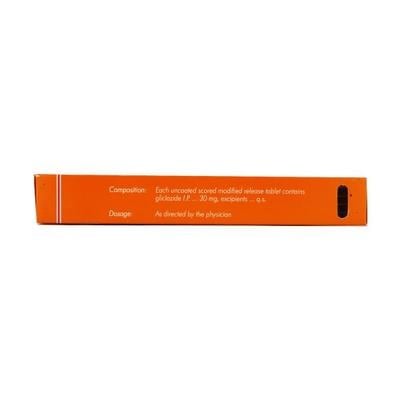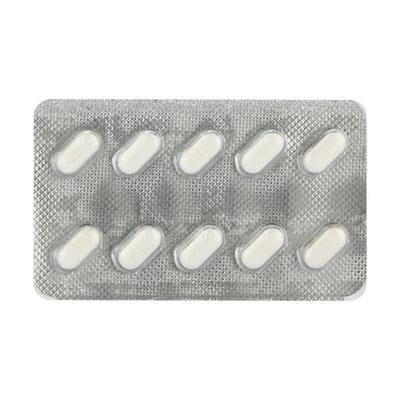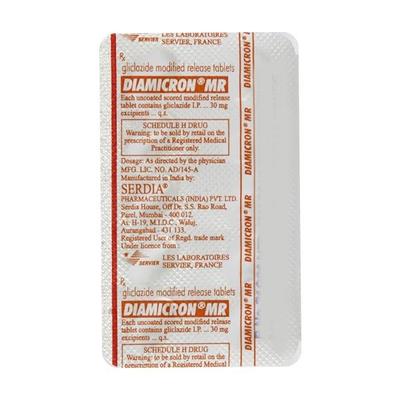

Netmeds First Membership
Quick Links
Introduction About DIAMICRON MR 30MG TABLET
Diamicron MR 30mg Tablet contains Gliclazide (Modified Release), commonly prescribed to support blood sugar management in individuals with type 2 diabetes. It helps optimize glucose levels when used alongside a guided lifestyle plan and regular monitoring.
Before treatment, inform your doctor if you have any liver or kidney problems. You must also inform your doctor if you have any hormonal problems, genetic disorders (such as G6PD deficiency), or if you are malnourished, starved, or on an irregular diet.
DIAMICRON MR 30MG TABLET is not suitable for use in patients with type I diabetes mellitus. Consult your doctor if you are pregnant, planning to become pregnant, or breastfeeding women. The most common side effects of taking DIAMICRON MR 30MG TABLET is hypoglycemia (low blood sugar levels). Your doctor will periodically monitor your blood sugar levels and adjust the dose of DIAMICRON MR 30MG TABLET accordingly.
Uses Of DIAMICRON MR 30MG TABLET
- Manages type II diabetes mellitus in adults
Benefits of DIAMICRON MR 30MG TABLET
- Supports Balanced Glucose Levels Throughout the Day
The modified-release (MR) formulation ensures a steady release of gliclazide, helping maintain stable glucose levels after meals. - Designed for Convenient Once-Daily Use
Diamicron MR 30mg is typically taken once daily with breakfast, making it easy to integrate into morning routines. - Modified-Release Technology for Better Consistency
The tablet’s formulation allows slow and continuous action, offering more predictable glucose support compared to immediate-release versions. - May Complement Diet and Lifestyle Measures
When used under medical guidance, it can be part of a broader strategy that includes food planning, physical activity, and regular glucose monitoring. - Suitable for Adults with Long-Term Glucose Management Needs
Often recommended as part of long-term routines in adults where consistent daily support is preferred. - Formulated for Better Tolerance in Some Individuals
The controlled release may help reduce sudden drops in blood sugar levels compared to non-MR forms.
How DIAMICRON MR 30MG TABLET Works
Gliclazide works by:
- Enhancing the natural release of insulin from specific cells in the pancreas (beta-cells).
- Helping the body utilize insulin more effectively over time.
- Reducing sugar buildup in the bloodstream, especially after meals.
The modified-release (MR) version of Gliclazide allows for gradual release throughout the day, supporting more stable glucose levels.
Modified Release Advantage
Unlike standard tablets, Diamicron MR:
- Releases the medicine slowly over 24 hours, mimicking the body's daily rhythm.
- Offers a more consistent effect on glucose levels, especially after eating.
- Reduces fluctuations compared to immediate-release formulations.
How to use DIAMICRON MR 30MG TABLET
Recommended Dosage and Frequency
- Diamicron MR 30mg is typically taken once daily, preferably in the morning.
- The exact dosage should follow the guidance provided by a healthcare professional, based on individual needs.
- Do not exceed the prescribed amount or adjust the dose without medical supervision.
Best Time to Take Diamicron MR – Morning or Evening?
- It is usually recommended to take Diamicron MR with or right after breakfast.
- Taking it in the morning aligns with the modified-release action, which supports steady levels throughout the day.
Can Diamicron MR Be Taken With Food?
- Yes, always take Diamicron MR with a meal, typically breakfast.
- Taking it on an empty stomach is not advised, as it may lead to lower-than-expected sugar levels in some individuals.
Dosage Tips for Elderly or Individuals With Kidney Concerns
- Dosage may need adjustment in older adults or those with kidney or liver considerations.
- Such patients should follow personalized medical advice, and regular monitoring may be recommended.
Should You Swallow, Split, or Chew Diamicron MR Tablets?
- Swallow the tablet whole with water.
- Do not chew, crush, or split the tablet, as this may interfere with its modified-release action.
How Long Should You Continue Using Diamicron MR 30mg?
- Continue using the tablet as long as recommended by your healthcare provider.
- Periodic assessments may be required to adjust the dosage or evaluate your ongoing routine.
What to Expect While Using Diamicron MR 30mg
- Improved glucose control with consistent usage and monitoring
- You may be advised to adjust your diet and exercise routine
- It may take a few days to notice stability in your sugar readings
What if I forgot to take DIAMICRON MR 30MG TABLET
- If you forget to take a dose, take it as soon as you remember during the same day.
- If it is almost time for the next dose, skip the missed dose—do not double up.
- Regular dosing at the same time daily helps maintain better balance.
Overdose
Consult your doctor immediately or visit the nearby hospital in case of overdosage. Symptoms of overdose include signs of low blood glucose levels such as weakness, sweating, trembling, a fast heartbeat, confusion, and double vision.
Side Effects Of DIAMICRON MR 30MG TABLET
Common side effects of DIAMICRON MR 30MG TABLET:
- hypoglycemia (low blood sugar levels)
- dizziness
- stomach pain, indigestion, diarrhea, or constipation
When to Seek Medical Advice Regarding Diamicron Side Effects
- severe allergic reaction (such as skin rash, swelling of the face, eyelids, lips, tongue, or throat that causes difficulty breathing or swallowing)
- signs of liver problems (such as fever, yellowing of the skin and whites of the eyes, weakness, fatigue, weight loss, and loss of appetite)
- signs of a severe decrease in blood sugar level (such as confusion, headache, excessive sweating, clammy skin, trembling, weakness, double vision, excessive hunger, nausea, vomiting, problems sleeping, depression, trouble seeing or speaking, paralysis, numbness, difficulty breathing, slowed or faster heartbeat with chest pain)
Warning & Precautions
Pregnancy
ContraindicatedDIAMICRON MR 30MG TABLET is not recommended for use by pregnant women. Animal studies have not shown direct harm to the unborn baby when given during gestation. Currently, there is insufficient well-controlled data available from human pregnancies to confirm safety.
Breastfeeding
ContraindicatedDIAMICRON MR 30MG TABLET is not recommended for use by breastfeeding women. Animal data suggest minimal secretion of gliclazide into breast milk. However, human data is limited, and the potential for glucose-lowering effects in the breastfed infant cannot be ruled out.
Driving and Using Machines
Use with CautionDo not drive or operate any machines if you feel dizzy or experience blurred vision after taking DIAMICRON MR 30MG TABLET.
Alcohol
Consult your doctorAvoid alcohol consumption as it could aggravate your existing condition.
Kidney
Consult your doctorDIAMICRON MR 30MG TABLET is not considered for use in patients with severe kidney disease. It should be used cautiously in patients with decreased kidney function.
Liver
Consult your doctorDIAMICRON MR 30MG TABLET is not recommended for use in patients with severe liver disease. It should be used cautiously in patients with decreased liver function.
Allergy
ContraindicatedDo not take DIAMICRON MR 30MG TABLET if you are allergic to Gliclazide or to any other medicines that belong to sulphonylureas (such as glibenclamide, glipizide).
Use In Pediatrics
ContraindicatedDIAMICRON MR 30MG TABLET is not advised for use in children and adolescents (aged below 18 years).
Use In Geriatrics
Use with CautionDIAMICRON MR 30MG TABLET should be used cautiously in elderly patients, especially in those who take medicines such as CNS depressants or beta-blockers.
Other Warnings for DIAMICRON MR 30MG TABLET
Before taking DIAMICRON MR 30MG TABLET, inform your doctor if you:
- are malnourished, starved, on an irregular diet, or feeling weak
- perform extreme physical exercises
- have hormonal problems (Ex. disorders of the pituitary gland, adrenal cortex, or thyroid gland)
Who should not take [GBNKEYWORD
DIAMICRON MR 30MG TABLET is not recommended for use if you:
- have type I diabetes (or insulin-dependent diabetes)
- have diabetic ketoacidosis (increased levels of sugar and ketone bodies in the blood)
- have a serious traumatic injury
- have G6PD deficiency (an inherited blood disorder)
- have porphyria (an inherited blood disorder)
Diet and Lifestyle Advice
Balancing daily habits with medicine use can help individuals maintain wellness and reduce discomfort associated with glucose fluctuations. While Diamicron MR supports blood sugar control, it works best alongside mindful routines.
1. Eat Balanced and Consistent Meals
- Include complex carbohydrates like oats, brown rice, and lentils for slow, sustained energy.
- Add lean protein sources like eggs, tofu, paneer, or fish in every major meal.
- Choose high-fiber foods (e.g., leafy greens, vegetables, whole grains) to support digestive and sugar regulation.
- Avoid skipping meals—especially breakfast—if you’ve taken your tablet.
2. Stay Physically Active
- Aim for at least 30 minutes of light to moderate activity most days (e.g., walking, yoga, cycling).
- Prefer post-meal walks to improve energy utilization.
- Resistance training twice a week can help support better metabolic health.
3. Hydrate Well
- Drink 1.5 to 2 litres of water per day unless advised otherwise.
- Herbal teas and infused water (without sugar) can be a good addition.
4. Manage Stress and Sleep
- Practice stress-reduction techniques like meditation, deep breathing, or journaling.
- Prioritize 7–8 hours of quality sleep, which helps balance hormone levels, including those related to sugar.
5. Monitor Your Body’s Signals
- Keep a simple meal and symptom journal if possible.
- Note if any food, sleep disruption, or activity pattern consistently leads to discomfort or fatigue.
- Share these observations during follow-ups with your healthcare provider.
6.Optional Add-On (Interactive Tools for Content Relevance)
- Include a downloadable “7-Day Blood Sugar-Friendly Meal Planner”
- Embed a printable “Daily Lifestyle Tracker”
Drug - Drug interaction
Medications That May Increase Gliclazide’s Effect
These may enhance the blood sugar-lowering effect:
- Antibiotics: Sulfonamides, clarithromycin
- Antifungals: Fluconazole
- Pain relievers: NSAIDs like ibuprofen
- Beta-blockers: May mask signs of low blood sugar (e.g., propranolol, atenolol)
- MAO inhibitors: Used in psychiatric conditions
- Blood thinners: Warfarin (requires dose monitoring)
Medications That May Reduce Gliclazide’s Effect
These may reduce the blood sugar-lowering potential:
- Corticosteroids (e.g., prednisolone)
- Oral contraceptives
- Thiazide diuretics (used in hypertension)
- Certain antiepileptics: Phenytoin
- Rifampicin (antibiotic for TB)
- Sympathomimetics: Like salbutamol, especially when given IV
Other Considerations
- Alcohol: May increase risk of fluctuations; best avoided or limited.
- Herbal or OTC supplements: Always share these with your prescriber or pharmacist.
- Insulin or other glucose-lowering agents: Using in combination may intensify effects—needs medical guidance.
Synopsis
| Drug | : | Gliclazide |
| Pharmacological Category | : | Sulfonylureas |
| Therapeutic Indication | : | Type II Diabetes Mellitus |
| Dosage Forms | : | Tablet, Capsule |
More Information
Compare Diamicron MR 30mg with Similar Medicines
|
Features |
Diamicron MR 30mg |
Glimepiride 1mg |
Metformin 500mg |
Voglibose 0.2mg |
|
Active Ingredient |
Gliclazide (Modified Release) |
Glimepiride |
Metformin |
Voglibose |
|
Drug Class |
Sulfonylurea |
Sulfonylurea |
Biguanide |
Alpha-glucosidase inhibitor |
|
How It Works (Mechanism) |
Supports insulin release in response to food |
Enhances insulin secretion |
Reduces sugar production in the liver and improves insulin action |
Delays absorption of carbs in the intestine |
|
Usual Dosing Frequency |
Once daily with first meal |
Once daily before breakfast |
1–2 times daily with meals |
2–3 times daily with meals |
|
Meal Timing |
Take with breakfast |
Take before first meal |
Take during or after meals |
Take just before meals |
|
Common Add-On In Combo |
Metformin |
Metformin |
Glimepiride / Dapagliflozin |
Metformin |
|
Use in Kidney Concerns |
May need adjustment |
May need adjustment |
Often avoided in advanced cases |
Used with caution |
|
Use in Elderly |
Start low, monitor closely |
Start low, monitor closely |
Often well-tolerated |
Dose needs individualization |
Did You Know? Interesting Insights About Diamicron MR 30mg
- Not All Gliclazide Tablets Are the Same
Diamicron MR 30mg uses a modified-release formula, which allows the medicine to work steadily over 24 hours, unlike conventional gliclazide tablets that release the full dose quickly. - Once-Daily Convenience
Thanks to its slow-release design, many people take Diamicron MR just once in the morning, making it easier to stick to a routine. - Designed to Work with Your Meals
Diamicron MR is more effective when taken with breakfast, as its action aligns with the body’s natural post-meal sugar rise. - Gliclazide Is on the WHO Essential Medicines List
Gliclazide, the active ingredient in Diamicron MR, is listed by the World Health Organization (WHO) as an essential medicine for managing chronic conditions. - Not Ideal for Splitting or Crushing
Crushing or breaking Diamicron MR tablets may disrupt its slow-release mechanism, so it should be swallowed whole. - Used Widely Across Age Groups
While typically prescribed for adults, careful dose adjustments may make Diamicron MR suitable for elderly individuals under close monitoring.
FAQs About DIAMICRON MR 30MG TABLET
Q: What is DIAMICRON MR 30MG TABLET taken for?
A: DIAMICRON MR 30MG TABLET is used in the management of type II diabetes mellitus when diet, exercise, and lifestyle changes alone do not result in an adequate response.
Q: How and when should I use DIAMICRON MR 30MG TABLET?
A: Use DIAMICRON MR 30MG TABLET before meals or as advised by your physician. Swallow the medicine with a glass of water. Do not crush or chew the medicine. Your doctor will decide the correct dose and duration of therapy for you depending on your age, body weight, and disease condition.
Q: Duration to take DIAMICRON MR 30MG TABLET?
A: You need to take DIAMICRON MR 30MG TABLET as long as your doctor prescribes you the medicine. Your doctor will decide the correct dose and duration of therapy for you depending upon your age, body weight, and disease condition.
Q: Can I stop taking DIAMICRON MR 30MG TABLET without consulting a physician?
A: No. You should not stop taking DIAMICRON MR 30MG TABLET without consulting your doctor as it may lead to a reversal of symptoms. If you feel better after using DIAMICRON MR 30MG TABLET, consult your doctor for advice. Your doctor might reduce the dose gradually before discontinuation of therapy.
Q: Will taking a higher dose of DIAMICRON MR 30MG TABLET be more effective?
A: No, taking a higher dose of DIAMICRON MR 30MG TABLET will not be effective, rather, it can lead to toxicity. If the prescribed dose is not effective for you, consult your doctor for advice. Your doctor might increase the dose or suggest an alternative therapy.
Q: What should I do if I forget to take a dose of DIAMICRON MR 30MG TABLET?
A: If you forget to take a dose of DIAMICRON MR 30MG TABLET, take it when you remember. However, if it is time to take the next dose, skip the missed dose and take the next one at regular times. Do not double the dose of DIAMICRON MR 30MG TABLET to compensate for a missed dose, as it could lead to toxicity.
Q: What cautions do I need to take while taking DIAMICRON MR 30MG TABLET?
A: Before taking DIAMICRON MR 30MG TABLET, inform your doctor if you have any liver or kidney problems, hormonal problems, genetic problems (surgery in the gut), or if you are malnourished. DIAMICRON MR 30MG TABLET is not suitable for use in patients with type I diabetes mellitus. Consult your doctor before taking DIAMICRON MR 30MG TABLET if you are pregnant or planning to become pregnant.
Q: Can I take medication for high blood pressure along with DIAMICRON MR 30MG TABLET?
A: No. It is not advisable to take medicines to control blood pressure while taking DIAMICRON MR 30MG TABLET without consulting your doctor. Therefore, consult your doctor before taking any antihypertensive such as beta blockers (Ex. atenolol, propranolol) along with DIAMICRON MR 30MG TABLET, as they have known interactions with DIAMICRON MR 30MG TABLET.
Q: What should I do if I have low blood sugar after taking DIAMICRON MR 30MG TABLET?
A: Try to have sugar-rich food items such as fruit juice, glucose tablets or gel, soft drinks, honey, or sugary candy. Check your blood sugar after 10 minutes. If you have not reached the optimum level, take another sugary snack or drink and check the blood sugar again. In cases of persistently low blood sugar levels, consult your doctor immediately.
Q: Can DIAMICRON MR 30MG TABLET cause dizziness?
A: Yes. Dizziness is a common side effect of using DIAMICRON MR 30MG TABLET.
Q: Can DIAMICRON MR 30MG TABLET be used with insulin?
A: Co-administration of DIAMICRON MR 30MG TABLET with insulin is considered risky as it increases the chances of decreased blood sugar levels. Consult your doctor before taking it.
Q: Can DIAMICRON MR 30MG TABLET be used in pregnant women?
A: No. DIAMICRON MR 30MG TABLET is not recommended for use by pregnant women.
References
1. K.D. Tripathi. Insulin, Oral Hypoglycaemic Drugs and Glucagon. Essentials of medical pharmacology. Seventh edition. 2013. Page – 270-272.
2. Shinnya Miwa, Hirotaka Watada, Ohmura chie and Yasushi Tanaka. Efficacy and Safety of Once Daily Gliclazide (20 mg/day) Compared with Nateglinide. ScienceDirect.com. August 2004. [Accessed on 25th July 2025] ![]()
3. Les Laboratoires Servier. Electronic Medicines Compendium (EMC). [Revised in July 2022] [Accessed on 25th July 2025] 
4. Accord. Electronic Medicines Compendium (EMC). [Revised in March 2021] [Accessed on 25th July 2025] 
5. Accord. Electronic Medicines Compendium (EMC). [Revised in March 2021] [Accessed on 25th July 2025] 
6. Balkanpharma-Dupnitsa AD. Electronic Medicines Compendium (EMC). [Revised in January 2021] [Accessed on 25th July 2025] 
7. Zentiva Pharma UK Limited. Electronic Medicines Compendium (EMC). [Revised in June 2021] [Accessed on 25th July 2025] 











